A Comprehensive Guide to Cultivating and Enjoying Exotic Delights
Hi everyone! I’m Marzi, and I’m thrilled to connect with you through this blog post. I want to tell you a bit about myself and why I wrote this post.
I’ve always loved nature and spending time in my garden. As I got more into gardening and sustainable living, I became fascinated by passion fruits. Their beautiful colors, sweet-smelling flowers, and unique flavors captured my attention like nothing else.
I’ve spent a lot of time learning about passion fruits, and I’ve faced both successes and challenges in growing them. Through lots of experimenting and research, I discovered the secrets to getting the best flavors and the most fruit from these delicate vines. I loved taking care of my own passion fruit orchard and wanted to share what I’ve learned with others.
That’s why I created this blog post. It’s a collection of my personal experiences, what I’ve learned from taking care of my passion fruit vines, and the research I’ve done. I wanted to create a helpful resource for other gardeners and people who love passion fruits.
But this blog post is more than just a guide. It’s also a celebration of the amazing flavors and smells of passion fruits.
I wanted to let you know that I wrote a recipe book called “50 Passion Fruit Recipes from Marzi’s Garden. I’ve created this book using my homegrown passion fruits and raw honey from my own beekeeping. They’re all desserts and sweet treats because that’s what I love making the most.” It’s available on Amazon, and it’s full of creative and tasty dessert recipes using passion fruits. If you’re interested, make sure to check it out.
So let’s dive into the world of passion fruits together! I hope this blog post helps you learn more about these amazing fruits and inspires you to try some delicious desserts. Enjoy your journey into the world of passion fruits!
Marzi
Table of Contents:

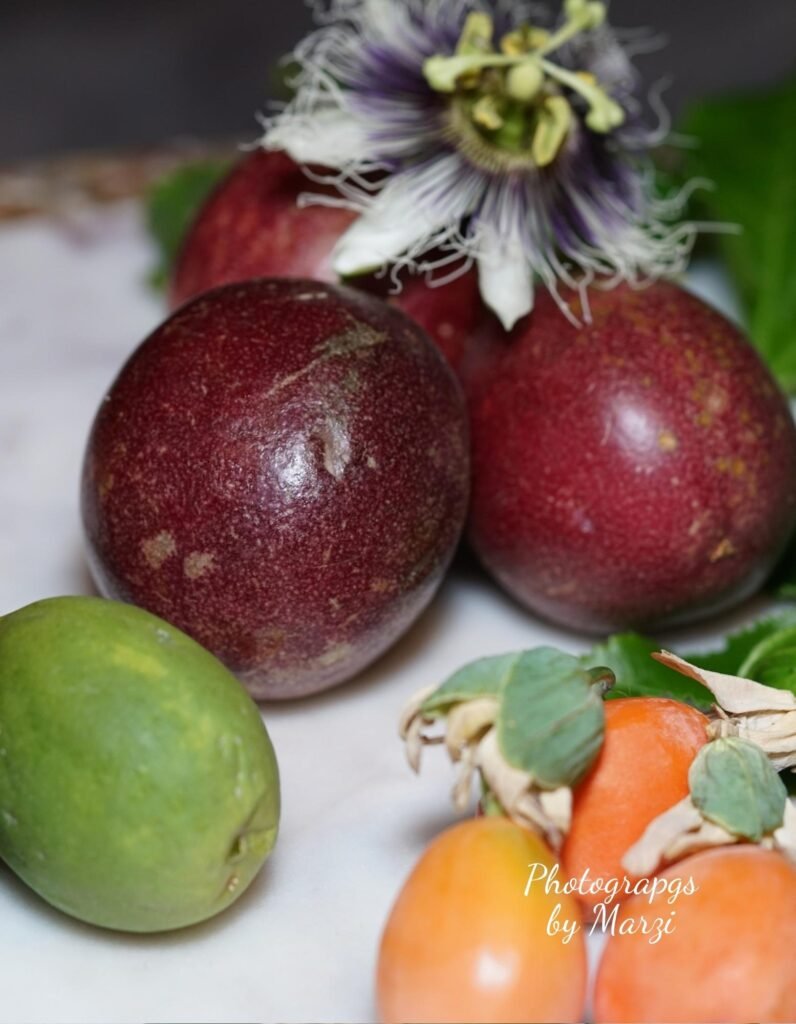
Lets talk about passionfruit . What is Passion Fruit ?
Passion fruit, a fruit that grows from the Passiflora vine, is a round or oval-shaped fruit with a tough, reddish-purple or yellow skin. The rind, when cut in half, looks like two bowls full of lumpy jelly. In this article, I will discuss the two main varieties of passion fruit among the 500 species that exist.
1- The purple passion fruit, or Passiflora edulis, is native to southern Brazil through Paraguay to northern Argentina. It is widely grown in southern California and Florida in the United States and thrives in zones 10-12.
2- The yellow passion fruit, or Passiflora edulis f. flavicarpa, is also known as tropical passionfruit or yellow Lilikoi. It has a more vigorous vine and generally larger fruit than the purple passion fruit, but the purple passion fruit has less acidic pulp, richer aroma and flavor, and a higher proportion of juice. The purple passion fruit has black seeds while the yellow passion fruit has brown seeds.
Passion fruit goes by different names in different countries. In Portuguese, it is called maracuja peroba; in French, grenadille or couzou. The purple passion fruit may be called purple, red, or black granadilla, lilikoi in Hawaii, mountain sweet cup in Jamaica, and linmangkon in Thailand. The yellow passion fruit is widely known as yellow passionfruit and called yellow lilikoi in Hawaii, golden passionfruit in Australia, and parcha amarilla in Venezuela.
Passion fruit is not only delicious but also full of vitamins that benefit your immunity, thyroid, and red blood cells. It is a versatile ingredient that can be used in many recipes. I have created an amazing passion fruit recipe book with some creative ideas for using passion fruit in food.
Additionally, passion fruit leaves and flowers have medicinal properties. I air dry the leaves and use them in tea to help with sleeping issues. Mixing passion fruit leaves with chamomile, valerian, lemongrass, and roses works best for sleeping issues. Fortunately, I grow all of these plants and can make my own tea mix.
My story with Passion fruits
I discovered my love for passion fruit during a vacation in Hawaii years ago. So when I learned that our new home in California had a huge passionfruit vine in the middle of the property, I was ecstatic.
While I’m not exactly sure of the variety, I suspect it’s the purple passion fruit (Passiflora edulis), which thrives in cooler winter climates. I’m particularly fond of this type because it’s a fast-growing, evergreen vine that flowers twice a year and is cold hardy.
Over the years, I’ve grown several other vines from cuttings of the main purple passionfruit vine, and they started fruiting just one year after transplanting. However, one downside to passionfruit vines is that they have a relatively short lifespan of around five to seven years. After three years, fruit production tends to slow down, which is why commercial growers often replace them. Last year, we had to replace our giant purple passionfruit vine after it had produced well for five years. We planted a new seedling grown from a cutting of the original vine in the same spot.

While I love the purple passion fruit, my favorite variety is the yellow Lilikoi. I brought the seeds from Hawaii in 2018, and they quickly germinated. One of the seedlings grew up to 30 feet long in just a few years and started flowering on the third year.
Now, in November 2022, my oldest Lilikoi vine is loaded with tons of flowers, most of which are turning into fruit. However, this variety needs cross-pollination to set fruit, so I’m hand-pollinating the flowers daily. I’ve successfully grown seven other passion fruit varieties that I purchased online.

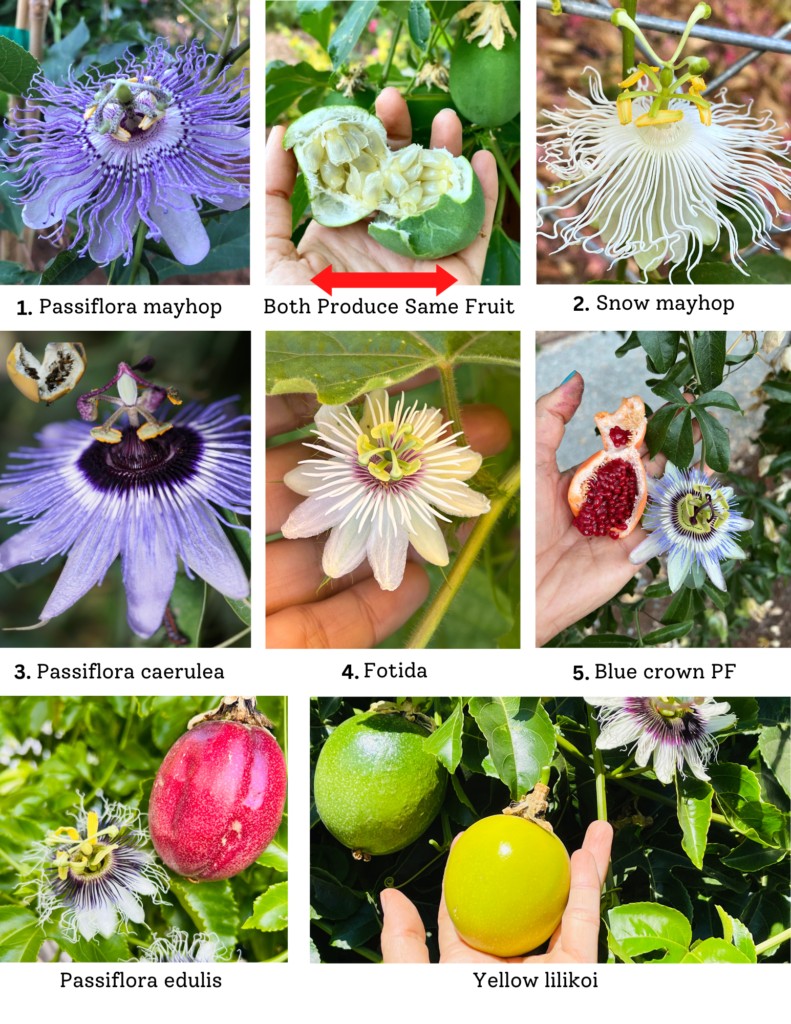

Caring for passion fruit vine..What Do Passion fruits Like And Dislike?
Sun & Temperature
In my experience, both our purple passion fruit and Lilikoi vines produce their best blooms and fruits when they receive full sun. While they can tolerate some shade, especially in extreme heat, it’s important to keep them in a spot with ample sunlight.
For those living in Zones 10-12, these vines can be kept outdoors year-round as long as the temperature stays well above freezing, particularly for yellow varieties. I’ve found that the purple passion fruit variety has adapted well to cold winters in Zone 9B. I’ve never covered my vines from rain or harsh winds, but providing some protection can be beneficial.
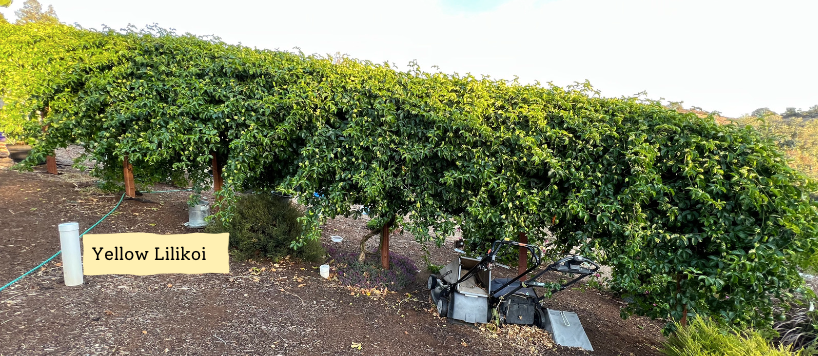
Soil
To grow passion fruit vines successfully, it’s important to choose the right soil type. While these vines can thrive in a variety of soil types, light to heavy sandy loams of medium texture are the most suitable. Good drainage is also essential to prevent collar rot.
In addition to soil type, soil health is also crucial for growing healthy passion fruit vines. This means having plenty of worms, microbes, and other organic matter in the soil. Maintaining the right soil pH is also important, with a range of 6.5 to 7.5 being ideal for passion fruit vines. If the soil is too acidic, applying lime can help. Poor soil quality can lead to problems with wilt diseases, root rot, and nematodes, while heavy clay soils can cause issues with rot diseases.
In my experience, planting alyssum as a companion plant can be a better alternative to using mulch around the trunk of the vine. Alyssum can attract bees for pollination, and also offer several other benefits for the soil and the plant’s overall health.

Fertilizers
To ensure proper growth, passionfruit requires ample nutrients. Fertile soils and additional fertilizers are recommended, and providing compost and mulch can greatly benefit the plant. To fulfill this, I personally create compost from kitchen scraps, quail and chicken manures, and worm castings. Feeding compost tea is also an easy and efficient method of fertilization.
I make my own compost tea by mixing aged chicken manures, fish emulsion, kelp, worm casting, blood meal, and bone meal in a large bucket with water, letting it sit for a day or two while stirring occasionally, then straining and diluting it before feeding it to all my plants.

While it’s generally believed that passionfruit requires full sun, a warm climate, and protection from wind, I live in zone 9B and have found that harsh winds and frost haven’t significantly harmed my vines. As long as the roots are established, the plants can survive damage from heat, cold, rain, or wind, and new growth will eventually emerge.
However, overfeeding passionfruit can lead to serious problems. Excessive nitrogen can turn leaves dark green, attracting harmful insects and reducing fruit production. Commercial growers typically use fertilizers with an NPK of 10-5-20, and gardeners are advised to use fertilizers high in potassium.
To fertilize my purple passionfruit, which flowers twice a year, I typically fertilize 3-4 times a year, just before blooming and once or twice while fruiting.
Support/Training/Pruning
Passionfruit vines require a sturdy support structure such as a fence, arch, or trellis as they can quickly grow heavy and large. The vines climb by using tendrils, and it is essential to choose a suitable planting location, as they can easily climb to the crown of nearby trees. Our passion vines are located near our pomegranate trees, and the red passionfruit hanging from them give the trees a Christmas tree-like appearance.
We have constructed numerous wooden arbor and framework structures, which stand at 8-10 feet high, specifically for our passion fruit vines. We tie the vines to the supports and allow the tendrils to find their way. To avoid damaging the stems, it is advisable to use fiber-based thread for securing them.
Pruning is crucial for the proper growth and health of passionfruit vines, as they tend to grow rapidly. Pruning helps to reduce their susceptibility to pests and diseases. It is recommended to remove all dead or dying stems, and to trim a maximum of one-third of the plant to maintain its size.
It is also important to prune any stems growing in the wrong direction and to ensure good air circulation by pruning the middle section. The best time for pruning is after fruiting has finished.
Water
Passionfruit vines require consistent watering, particularly during fruiting season. Nevertheless, they cannot endure soil that is waterlogged. It is important to ensure that the location you choose for planting is well-draining.
Both overwatering and under watering can lead to problems. In one scorching summer, we had a mishap where our irrigation system had stopped functioning for a few days without our knowledge. I observed that the leaves were changing color and the plant seemed sad, indicating that it was thirsty. Upon checking the base of the trunk, I discovered that the soil was dry up to 6 inches deep. We rectified the situation immediately.

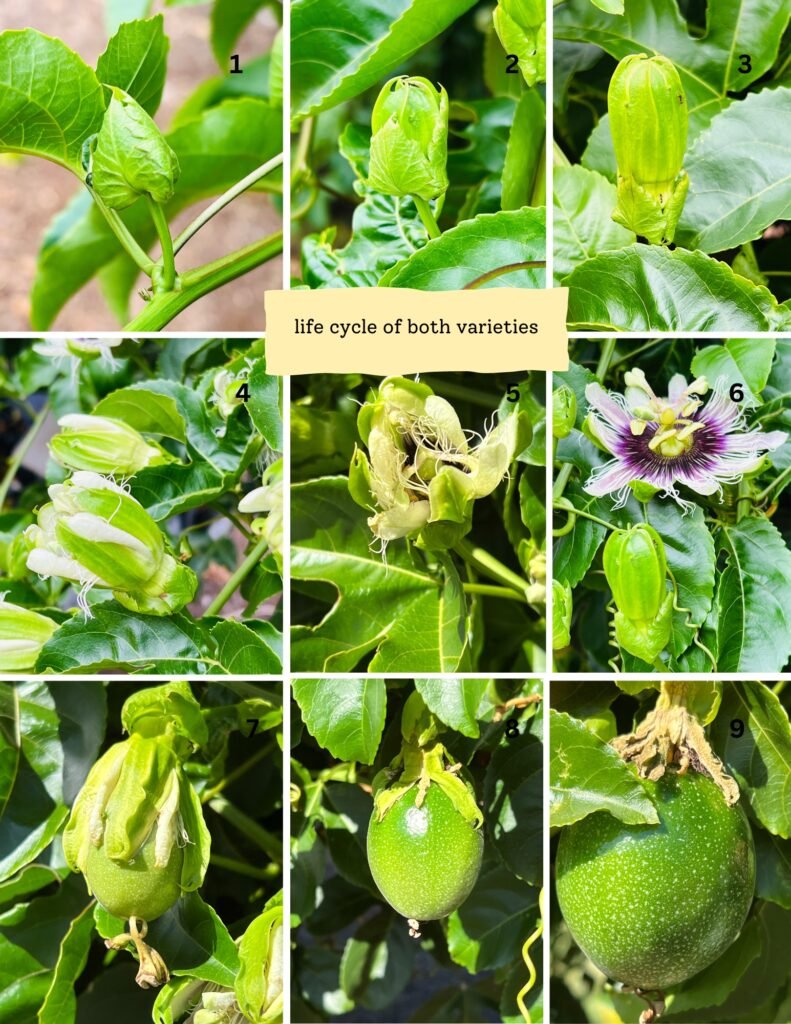
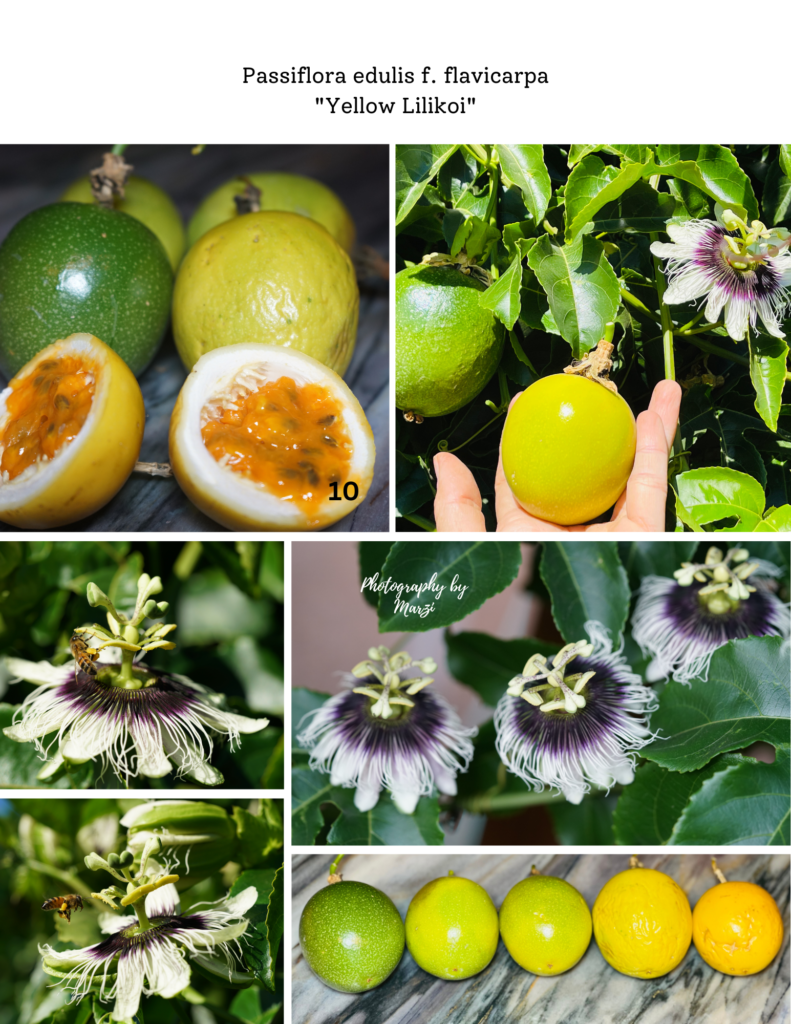

Pollination
To achieve successful pollination in passion fruit vines, warm temperatures and humid conditions are essential. High humidity is necessary for successful pollination while dry, hot, or cold weather and heavy rainfall can be detrimental. In my experience growing purple passion fruits in zone 9B, they thrive in subtropical climates.
While purple passion fruit can be self-pollinated, wind pollination is not possible as the pollen is too sticky. Therefore, bees are the only pollinators for passion fruit flowers, and a lack of bees will result in no fruit production.
To ensure good pollination, gardeners should plant a variety of herbs and flowers that attract bees. In our orchard, we have our own apiary to help with pollination and ensure a year-round harvest of passion fruits and other fruits.
Yellow passionfruit, on the other hand, is mostly self-incompatible and requires cross-pollination with a different cultivar. If only one passionfruit vine is planted, a second vine of a different cultivar is needed for cross-pollination.
In our orchard, we planted our purple passion fruit vine alongside our yellow lilikoi, about 20-30 feet apart, so they can’t reach each other but grow beside each other. When the yellow lilikoi flowers start blooming in late summer, I collect pollen from the purple passion fruits daily and pollinate the yellow lilikoi flowers using an eyeshadow brush. The flowers stay open for 24 hours, and if pollinated, they set fruit in less than 10 days, which ripen in about 60-80 days and fall to the ground.

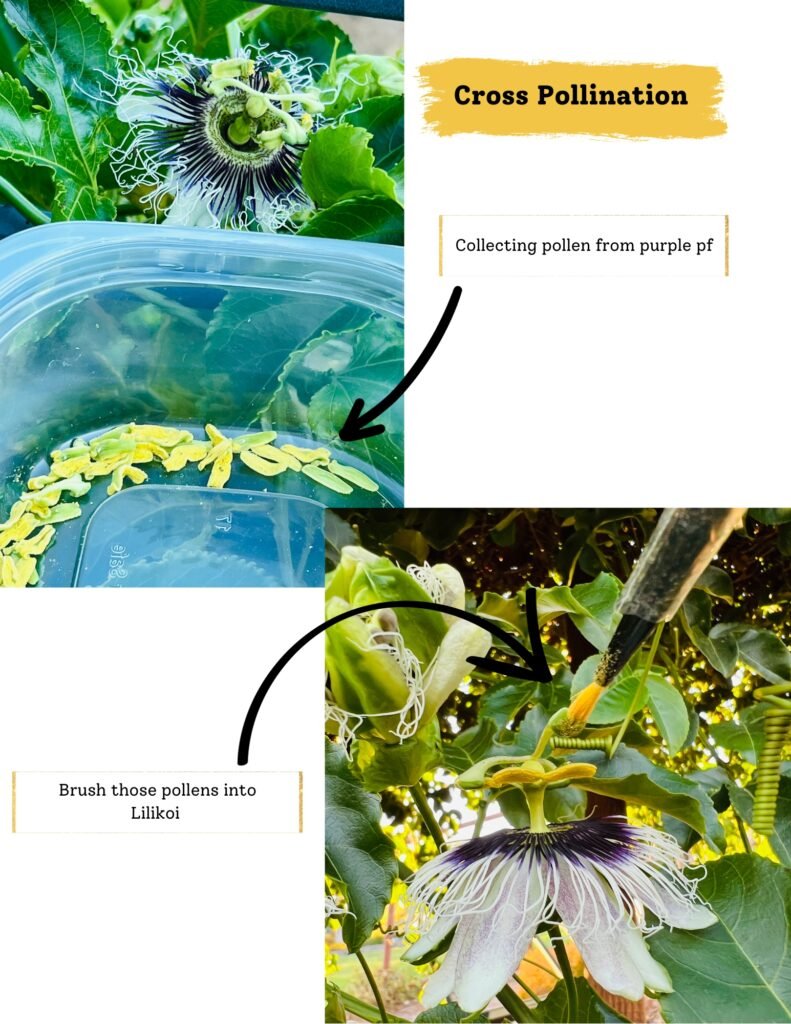
Propagation
I enjoy collecting seeds from exotic fruits that I find in the wild, buy from stores or eat at restaurants. I have successfully grown mangoes, star fruits, and passion fruits from seeds, except for yellow Lilikoi, which I brought from Hawaii six years ago. This fruit produces the best big juicy passion fruits I have ever tasted.
The most common way to propagate passion fruit is from seeds. Fresh seeds have higher germination rates, but old seeds may take longer to germinate. To germinate my seeds, I soak them in water and sometimes add liquid kelp for a day or two before inserting them into soaked peat pallets in a tray.
I place the tray on a heated mat with a dome to cover it to retain moisture, and a plant lamp on top. After a week when the seeds have germinated, I remove the heated mat and keep the dome on until the plant grows to 4-5 inches. Then, I transfer my new plants into a 4”-6” pot and keep them indoors with lights overhead until they have well-established roots, around 6 – 8 weeks. If the weather is warm enough, I transplant them outside to their final location either in the early morning or evening.
While I have successfully grown passion fruit vines in giant containers outside, I have learned that they prefer to grow in the ground. It is important to note that hybrid seeds are not viable, and purple passion fruit seedlings are more susceptible to Fusarium wilt. Hence, it is best to propagate them through stem cuttings.
I have grown many purple passion fruits from stem cuttings by keeping them in a jar of water near a window for a few weeks. When the roots start to appear, I plant the rooted stems in small pots with rich potting soil. If the weather outside is cold, I keep them indoors by a sunny window until the frost passes before transplanting them to their final location outside. It is crucial not to disturb the roots while planting, and I dig a hole at least twice the size of the root ball and mix the soil with compost. I put mulch around the plant and water it immediately. If needed, I tie the vine to the support until it starts to climb.
Alternatively, you can plant the rooted stems directly outside in fertilized soil if the weather is not too cold or hot. If planted outside in spring, you may get fruits in the same year.
To create a visually appealing garden, I plant alyssum flowers around the new passion fruit vines instead of mulch. Alyssum flowers are annual, fast-growing, and self-seeding, making them an excellent companion plant that attracts bees and other beneficial insects.
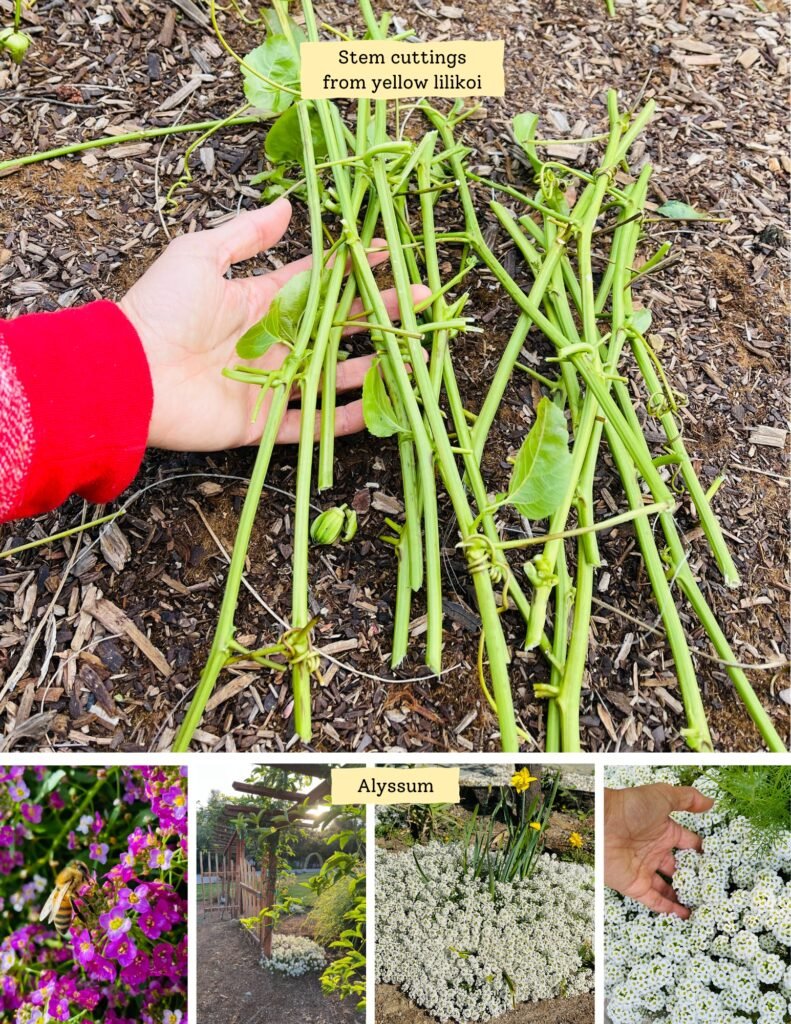
Pests and Diseases
I’ve never encountered any issues with pests or insects on my purple passion fruit or yellow lilikoi vines, except for passion butterflies, specifically Mexican fritillaries. These butterflies are known to be major pests for passion vines, particularly mayhops, which serve as their host plants.
Since I grow a few different varieties of mayhops, my garden has become a habitat for many butterflies. I even recorded a video of their life cycle in my garden.
Thankfully, the passion butterflies are mostly attracted to my mayhops and not my purple or yellow passion fruit vines.
I’ve also included some photos of four passion vines I cultivate in my garden that serve as host plants for Mexican fritillaries. I’ve provided their names and images for your reference.
Although I do notice a lot of ants on my passion fruit vines even when they aren’t flowering, they only feed on the nectaries located outside the flowers, which produce nectar and don’t harm the plants.
In addition to passion butterflies, other potential threats to passion fruit vines include fungal, Fusarium wilt, crown rot, scab, and viral diseases. However, these issues can often be prevented with good routine care since passionfruit vines are typically hardy plants.
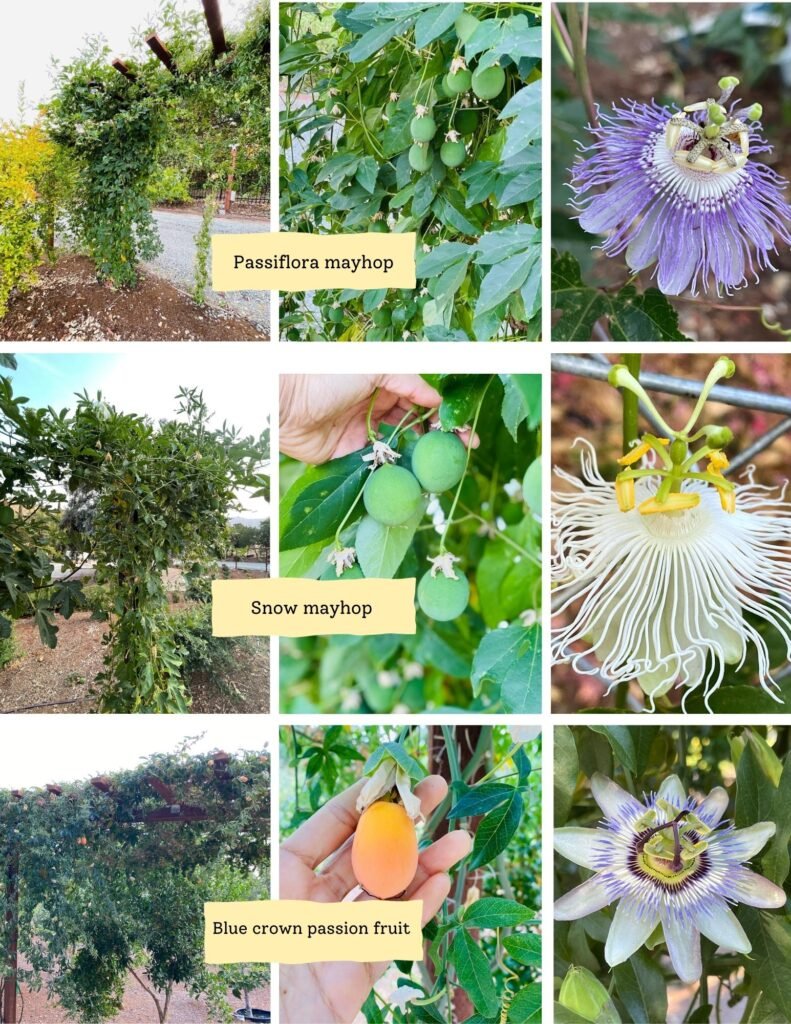


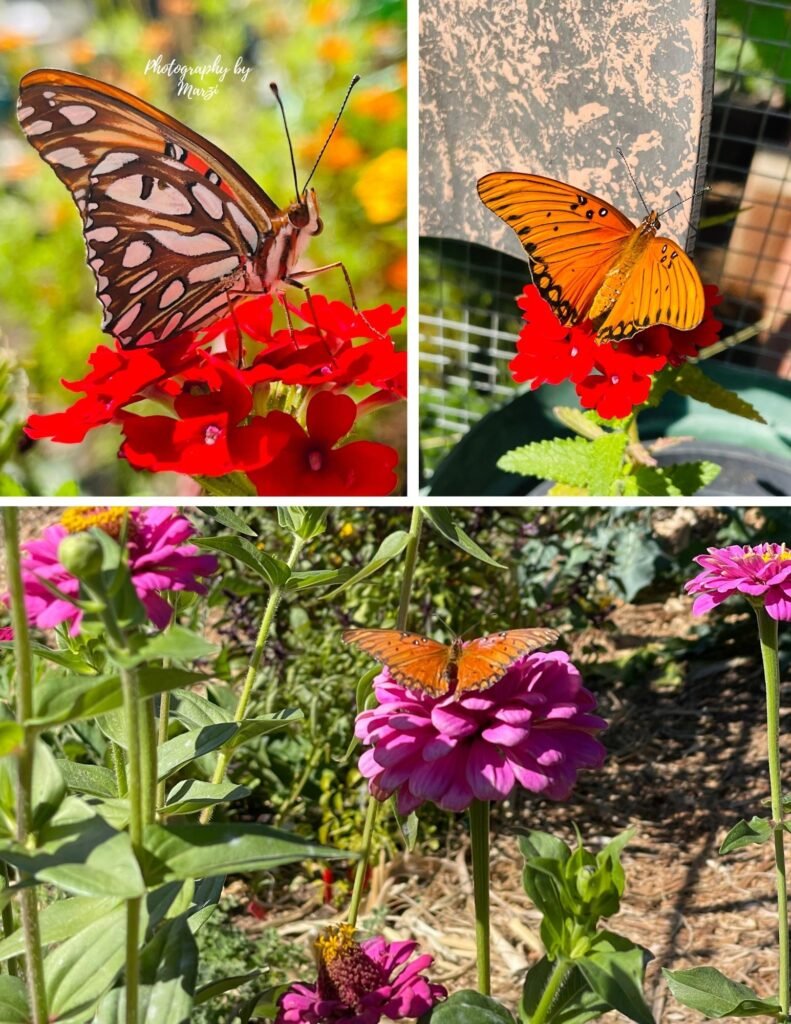
How Long Does Passion fruit Take To Fruit? and when to harvest?
The time it takes for passion fruit to mature and produce fruit depends on various factors. Tropical varieties tend to fruit more quickly than purple passion fruit, and warm climates can also speed up the process.
My purple passion fruit vine typically fruits twice a year, starting in late February and again in August. If you plant passion fruit in early spring, they may start fruiting in as little as six months. When the fruit is ripening, it falls off the vine and often gets stuck between or on the upper parts of the plant. I check the fruit daily and collect it as it falls. Fortunately, the fruit doesn’t get damaged when it drops, and it can sit on the ground for up to 2-3 days and still be good to pick up. While some fruits may be chewed open, possibly by squirrels, I’ve found that not many animals are interested in passion fruit.
What Passionfruit Taste like and how to eat it?
Personally, I have a fondness for sour flavors, and the pulp of passion fruit is a perfect blend of sweet and sour tastes. To fully savor the flavor, it’s best to wait for the fruits to become more wrinkled and shrunken, usually after a week or longer. Once they reach this stage, I cut them open and indulge in the delightful mixture of tartness and sweetness. I particularly relish the pulp when sprinkled with a bit of salt, and sometimes I add a drizzle of honey to enhance the taste even more.
Since I harvest so many passion fruits each year, I have come up with many inventive recipes featuring passion fruits that utilize only raw honey from my apiary. You can find my book of recipes here.
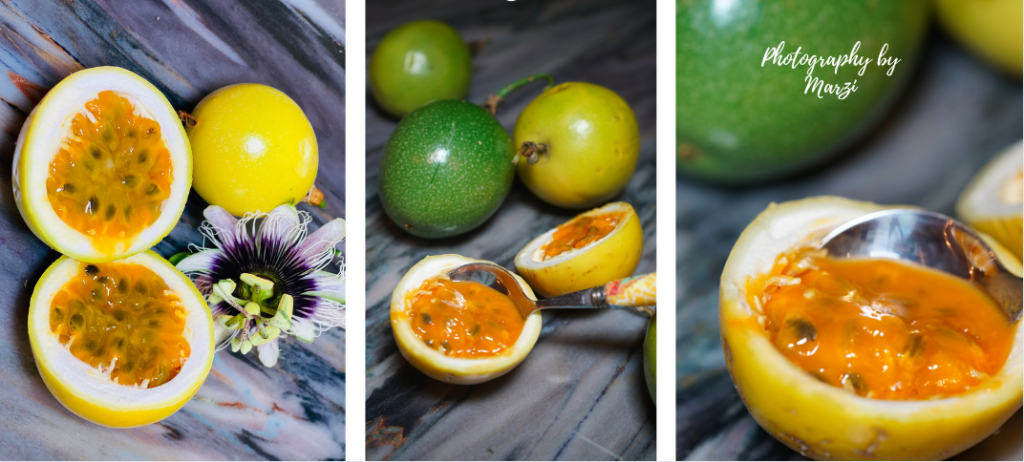
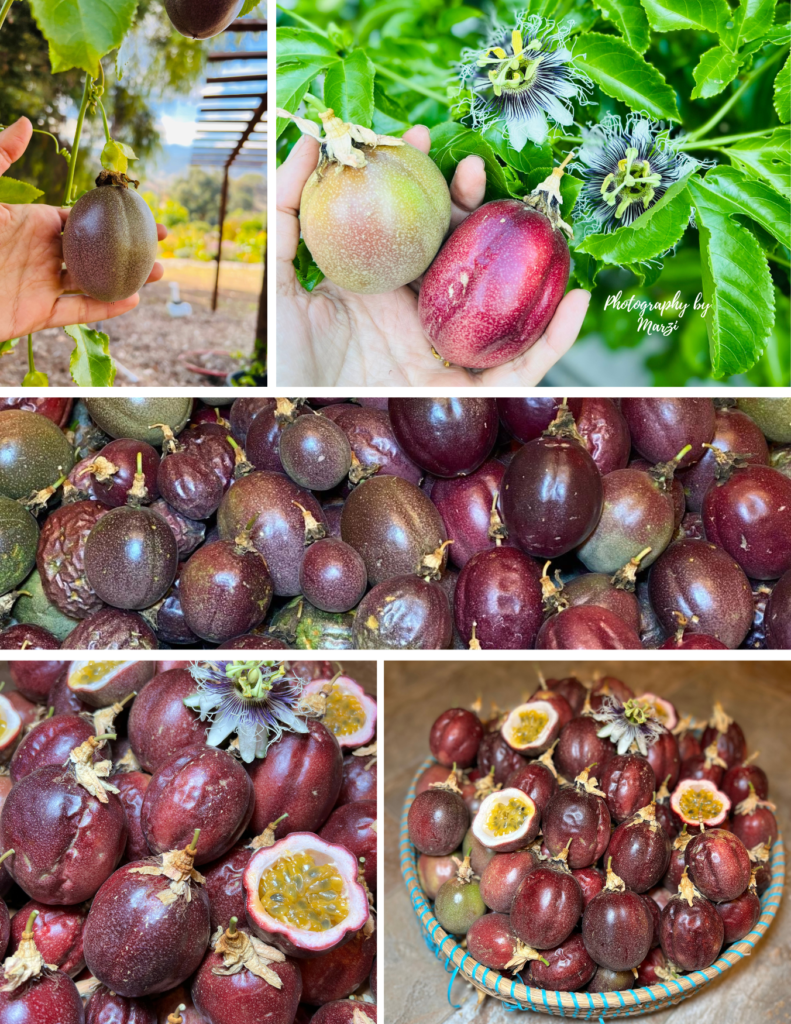

Storing
When fully ripened, purple passion fruits are best consumed fresh as they are sweet. In contrast, yellow passion fruits are commonly used for making preserves or juice. Both types can last for a few weeks without refrigeration, and they can last even longer when refrigerated.
If the fruits were picked slightly unripe, they can be left on the counter for a few days to ripen. As the fruit ages, the skin will wrinkle, but the pulp inside will remain delicious. However, it’s important not to wait too long as the fruits will become tough and inedible. To preserve the pulp, I usually collect it and store it in the freezer or fridge until I’m ready to make a drink or dessert with it.
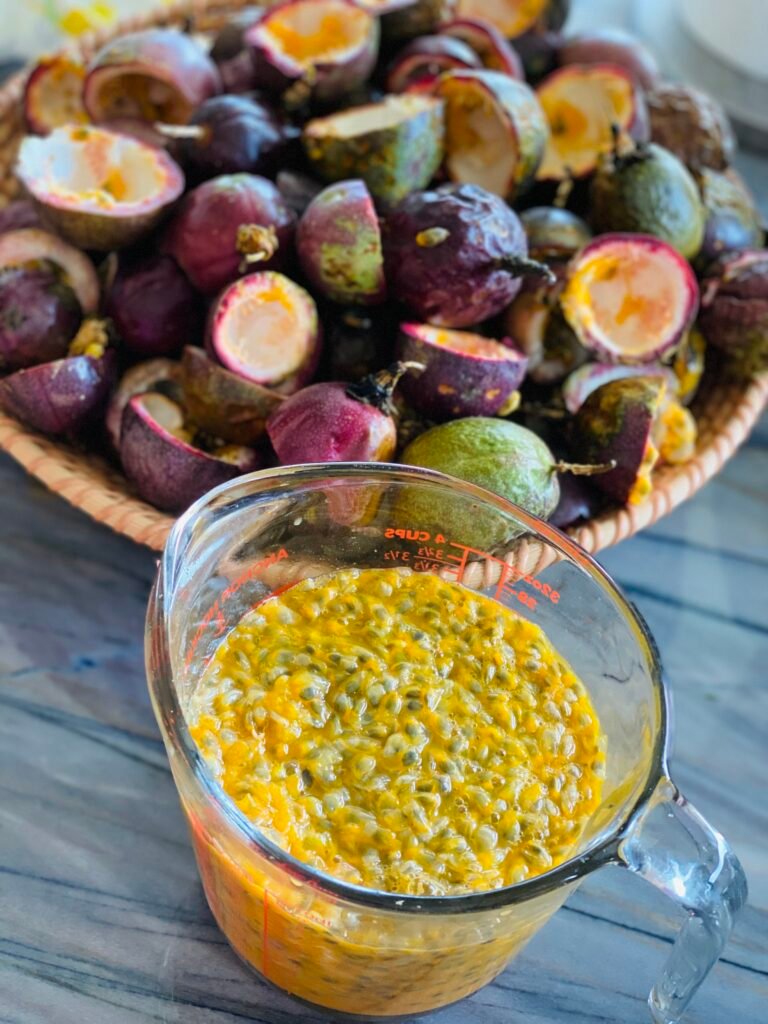
Conclusion
In this captivating journey through the world of passion fruit, we’ve uncovered the secrets and delights of this extraordinary fruit. From its origins and diverse varieties to the pleasures and nuances of growing it, we’ve explored the enchanting realm of passion fruit.
Passion fruit is not merely a fruit; it’s a symphony of flavors and a treasure trove of health benefits. Its unique taste, adaptability in culinary creations, and medicinal value make it a true gem for enthusiasts of both fine dining and natural wellness.
As i wrap up this blog post, I encourage you to indulge in the delectable pulp of passion fruit and experiment with the array of recipes provided. Let this book be an inspiration for you to cultivate your own passion fruit vine and experience the joy of growing a piece of nature’s marvel in your own garden.
For more tantalizing passion fruit recipes and a deeper dive into the world of passion fruit, do explore my book, “50 Passion Fruit from Marzi’s Garden“, available on Amazon. Simply scan the QR code below to directly access the sales page and embark on a culinary adventure with passion fruit.

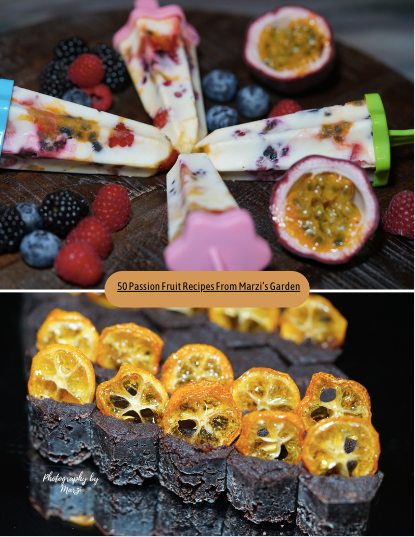
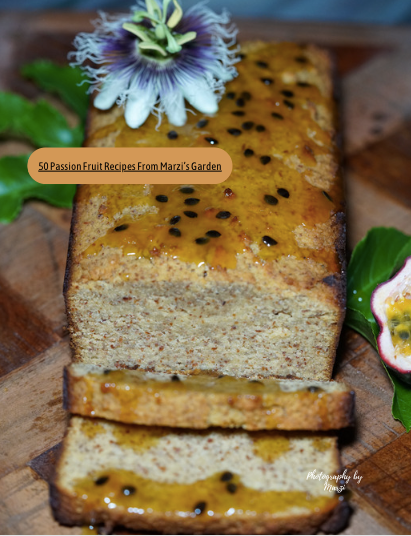
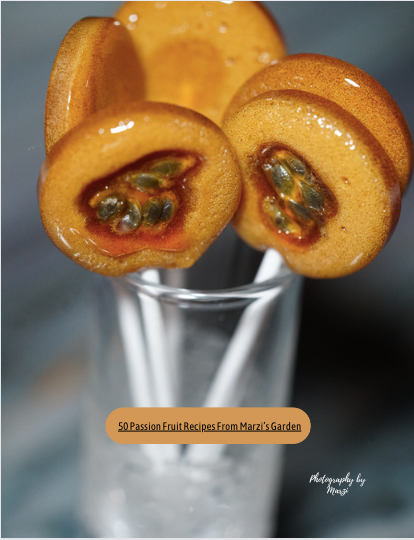
Don’t forget to check my 5 Handpicked Passion Fruit Dessert Recipes .
As an Amazon influencer, I earn a commission through product links at no extra cost to you—your support is appreciated!
Your feedback and comments are invaluable, helping my page thrive. Stay tuned for more exciting recipes and gardening adventures. Happy cooking and gardening!

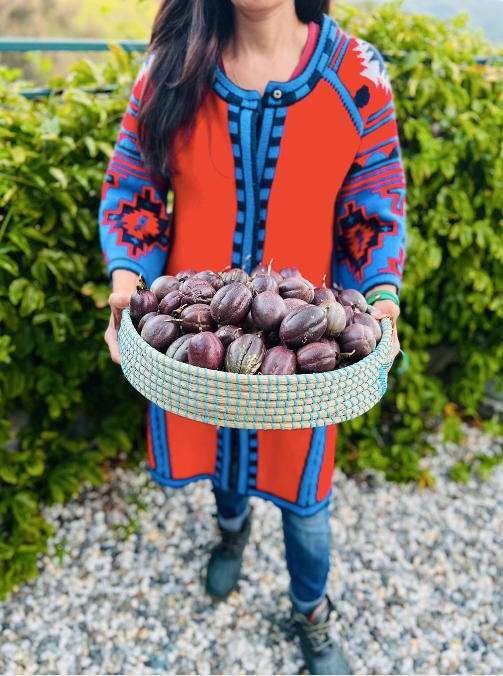

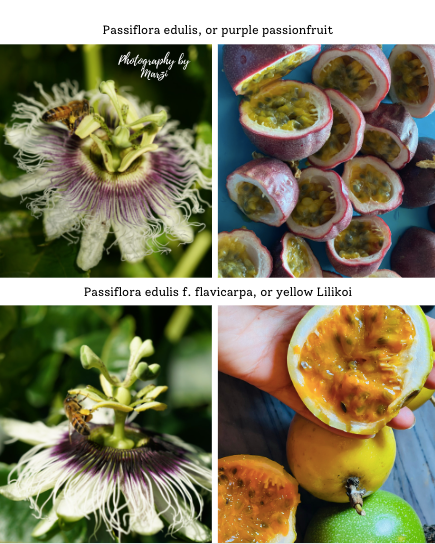
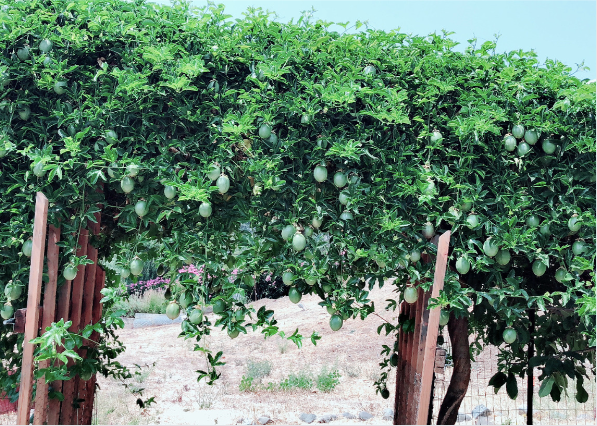

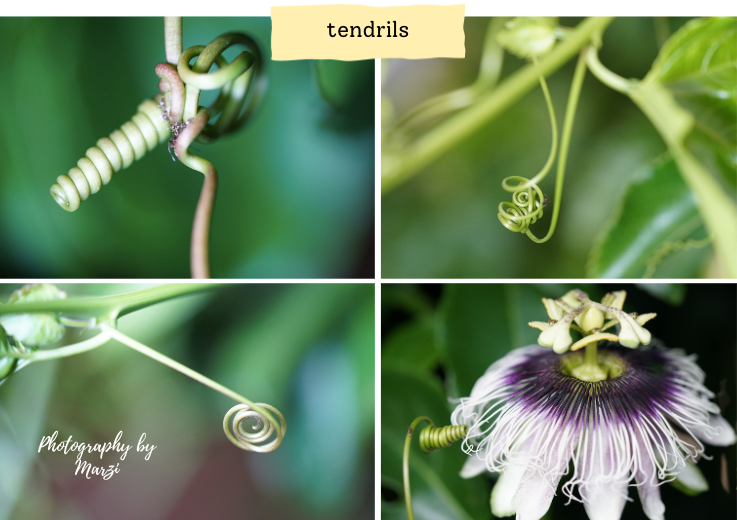
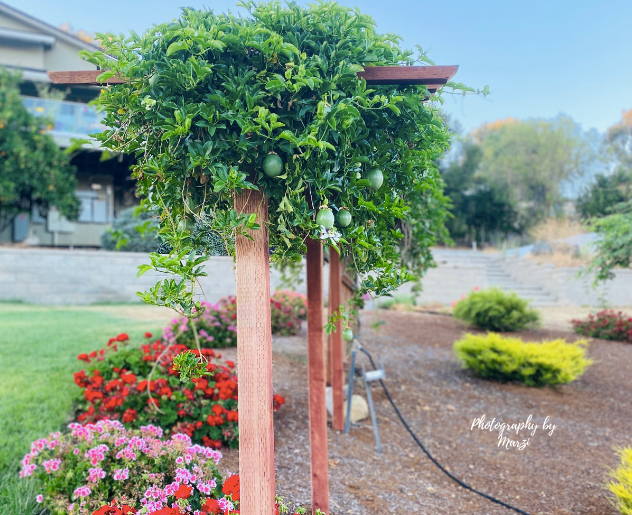
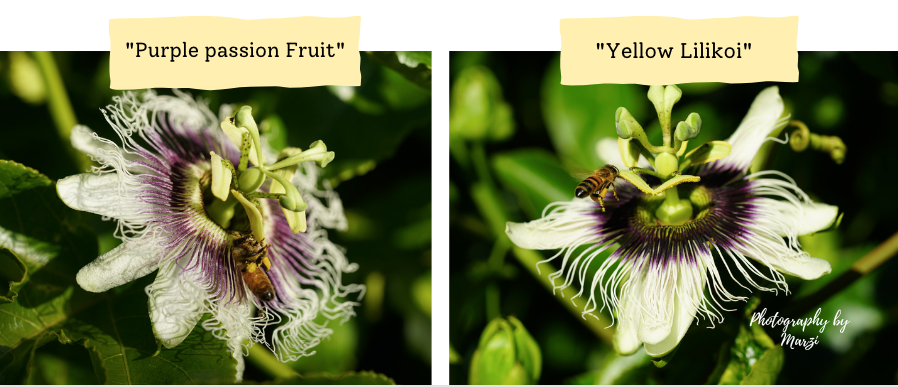



Very interesting info!Perfect just what I was searching for!Leadership